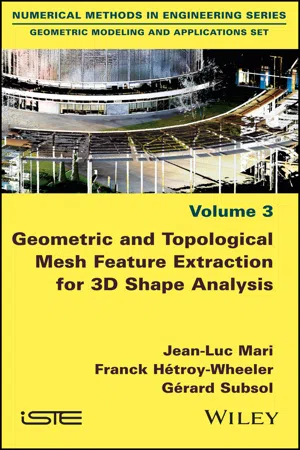
Geometric and Topological Mesh Feature Extraction for 3D Shape Analysis
- English
- ePUB (mobile friendly)
- Available on iOS & Android
Geometric and Topological Mesh Feature Extraction for 3D Shape Analysis
About This Book
Three-dimensional surface meshes are the most common discrete representation of the exterior of a virtual shape. Extracting relevant geometric or topological features from them can simplify the way objects are looked at, help with their recognition, and facilitate description and categorization according to specific criteria. This book adopts the point of view of discrete mathematics, the aim of which is to propose discrete counterparts to concepts mathematically defined in continuous terms. It explains how standard geometric and topological notions of surfaces can be calculated and computed on a 3D surface mesh, as well as their use for shape analysis. Several applications are also detailed, demonstrating that each of them requires specific adjustments to fit with generic approaches. The book is intended not only for students, researchers and engineers in computer science and shape analysis, but also numerical geologists, anthropologists, biologists and other scientists looking for practical solutions to their shape analysis, understanding or recognition problems.
Frequently asked questions
Information
1
Geometric Features based on Curvatures
1.1. Introduction
1.2. Some mathematical reminders of the differential geometry of surfaces
1.2.1. Fundamental forms and normal curvature







Table of contents
- Cover
- Table of Contents
- Preface
- Introduction
- 1 Geometric Features based on Curvatures
- 2 Topological Features
- 3 Applications
- Conclusion
- References
- Index
- End User License Agreement